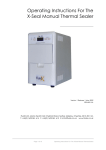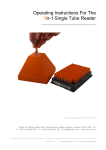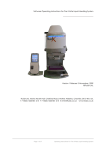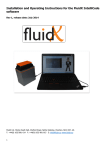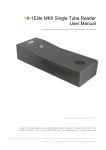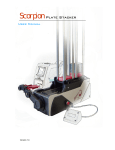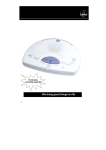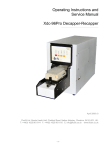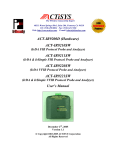Download HT300A USER MANUAL
Transcript
Operating Instructions For The X-Seal Manual Adhesive Plate Sealer __________________________________ Release 1.1 May 2009 FluidX Ltd. Monks Heath Hall, Chelford Road, Nether Alderley, Cheshire, SK10 4SY, UK. T: +44(0) 1625 861 614 F: +44(0) 1625 861 615 E: [email protected] Page 1 of 10 www.fluidx.co.uk Operating Instructions For The X-Seal Manual Adhesive Sealer This document is for information only; the manufacturer accepts no liability for errors contained herein or for incidental or consequential damages with the furnishing, performance, or use of this material. Unless otherwise specified references to names or parts is purely casual and has the purpose of illustrating the product. The contents of this publication may not be reproduced in any form or by any means (including electronic storage and retrieval or translation into a foreign language) without prior agreement and written consent from the copyright owner. The information contained in this document is subject to change without notice. Page 2 of 10 Operating Instructions For The X-Seal Manual Adhesive Sealer TABLE OF CONTENTS 1. DIAGRAMS 4 2. QUICK START INSTRUCTIONS FOR UNITS ALREADY SET UP 6 3. UNIT SET-UP 6 4. ATTACHING ROLL OF FILM OR FOIL 7 5. SECURING THE GLIDE RAIL 8 6. ADJUSTING THE GLIDE RAIL 9 7. ALTERNATIVE GLIDE RAILS 10 Page 3 of 10 Operating Instructions For The X-Seal Manual Adhesive Sealer 1. DIAGRAMS i. Diagram 1; Instrument overview ii. Diagram 2; Close up of glide rail attachment points iii. Diagram 3; detailed illustration for attaching film or foil iv. Annotation for all diagrams; 1 Thumbscrews 2 Fine adjustment bracket 3 Adjustment feet 4 Backing film roller 5 Backing film roller adjustment 6 Hinged roller catch 7 Hinged roller 8 Film guide 9 Front film roller set 10 Film roll a Direction for plate insertion b Direction of plate exit Diagram 1- Instrument Overview Page 4 of 10 Operating Instructions For The X-Seal Manual Adhesive Sealer Screw holes Front Screw holes Screw Screw Diagram 2- Close up of glide rail attachment points collected carrier paper coil around coil around foil carrier paper Diagram 3- Detailed illustration for attaching film or foil Page 5 of 10 Operating Instructions For The X-Seal Manual Adhesive Sealer 2. QUICK START INSTRUCTIONS FOR UNITS ALREADY SET UP Sealing microplate with foil. i. Turn on the main switch at the back of the sealer. ii. Check that the green LED is illuminated (found on the top of the system towards the back of the unit). Should the red LED be illuminated press the reset button found on the back of the unit. iii. Place the plate to be sealed on the left of the guide rail (diagram 1(a)). iv. Push the plate in from the left into the sealer. v. The sealer starts automatically when the plate is recognised. vi. The plate is travels automatically to the right and is sealed with foil. vii. The plate is ejected from the sealer on the right hand side (diagram 1(b)) and can then be removed. viii. If required, the film or foil "tails" can be bent over and sealed against the sides of the microplate 3. UNIT SET-UP Using 100 meter foil-rolls. i. A backing paper roll is included with every 100m roll of film. This ensures that, when finished, the roll of backing paper can be removed quickly and easily from the system and discarded. ii. If there is a roll of used backing paper remove the backing paper roller assembly by first removing the thumb wheel (diagram 1(5)), then the washer and front guide disc. Take care not to lose the spring or collar. iii. The roll of used backing paper can now be removed. iv. The new backing paper roller can now be fitted by reversing the process in 4.1 to 4.3 v. When refitting the retaining thumbscrew first fully tighten the thumbscrew (by turning clockwise) and then turn one full turn anti-clockwise to loosen slightly. vi. The backing paper assembly is now adjusted. The new roll of film or foil can be fitted as described in section 4. Page 6 of 10 Operating Instructions For The X-Seal Manual Adhesive Sealer 4. ATTACHING ROLL OF FILM OR FOIL i. Ensure the sealer is turned off. ii. Remove the guide rail (if fitted) by unscrewing the retaining thumbscrews (diagram (1)).This is achieved more easily by moving the unit to the front of the bench so that the glide-rail is overhanging the edge. iii. Put the roll on the laboratory bench on the left of the unit so that start of the foil is above and the foil is feeding off the roll from the top (you should only be able to see the foil or film, not the backing paper). iv. Feed the film between the two rollers that form the front roller set (diagram 2(9)) from left to right. v. Now feed the film back around the lower of the two rollers (diagram 2(9)). The film should now be pointing back towards the roll of film. vi. Move the roll of film into position resting freely in the film guide (diagram 2(8)). WARNING. During normal use the foil is cut using a sharp steel scalpel blade, fitting the foil requires feeding the foil close to the blade. The blade should be recessed within the housing but care is required as inappropriate use of the unit can result in the blade becoming exposed. vii. Unlock the hinged roller catch (diagram 2(6)) and rotate the hinged roller upwards (anticlockwise) (diagram 2(7)). viii. Feed the film between the two steel rollers and re-tighten the hinged roller catch. Make sure the hinged roller is replaced so that the catch is horizontal, otherwise it may interfere with the plate movement. ix. Separate carrier paper from the foil. x. Pull the foil through from the roll so that about 20cms of foil is exposed below the bottom roller and attach lightly to the laboratory bench on the right. xi. Now feed the carrier paper around the hinged roller and up to the backing-pape roller diagram 1(4)). The backing paper should feed up onto the right hand side of the roller so that it will roll anti-clockwise around the roller. The carrier paper should be attached to the roller with a piece of adhesive tape. Ensure that the paper is positioned centrally within the roller. xii. Wind the carrier paper 1-2 revolutions by hand. xiii. If not already completed refer to the instructions for tensioning the backing paper roller in section 3. xiv. Now trim the exposed foil with a sharp pair of scissors so that there is about 1cm extending down from the lowest roller. xv. Fit the glide-rail (see Section 5). Page 7 of 10 Operating Instructions For The X-Seal Manual Adhesive Sealer 5. SECURING THE GLIDE RAIL i. Ensure the sealer is turned off. ii. Locate the brass retaining fixtures (diagram 3) at the bottom of the front case on both sides of the unit. iii. Pull the sealer towards the edge of the laboratory bench so that the front of the unit is at the edge of the bench iv. Hold the guide-rail in one hand and screw the thumbscrews (diagram 1(1)) by hand, 2-3 turns. Note: All standard glide-rails use the lower pair of retaining holes Markings will be seen on the glide-rail if fitting a custom glide-rail designed for use with the upper set of holes. v. Move the glide-rail to the left and right to ensure it is seated correctly and then lift up to its highest position and move the unit back on the laboratory bench so that the whole unit (including the glide-rail) is sitting securely on the bench. The glide-rail should move up and down easily, if not check that the bolts are not over-tightened. vi. Move the glide-rails down, so that the four adjustable feet (diagram 1(3)) are positioned firmly on the table. vii. Position the fine-adjustment bracket (diagram 2(2)) into one of the 3 holes located directly above the bracket on the front of the main unit. viii. Move the glide-rail forwards and backwards to correctly position the bracket. ix. The stop claw should be mobile in the hole. x. Tighten the thumbscrews (diagram 1(1)). xi. The unit is now ready to use. A test plate should be run to check sealing pressure. The first test plate may have very long "tails" depending on how the foil was trimmed (4.14) xii. Occasionally spray the glide rail sparingly with a silicon or PTFE lubricant. Page 8 of 10 Operating Instructions For The X-Seal Manual Adhesive Sealer 6. ADJUSTING THE GLIDE RAIL I. A plate sealed with the Manual Adhesive Sealer should: a. Be sealed with an even pressure form left to right and front to back. b. Be sealed with enough pressure to clearly see the well edges on every well. c. Not be sealed with so much pressure that the film or foil has stretched unduly (some edge stretching however is acceptable). II. If the plate is sealed unevenly from left to right it suggests that the glide-rail is not parallel with the main unit (viewed left to right). This can be adjusted by raising or lowering the adjustable feet (diagram 1(3)). III. A small spanner is needed to loosen the locking nuts. The feet can be adjusted as required and the locking nuts re-tightened. During this process ensure that the fine adjustment bracket (diagram 1(2)) is loose in its fixture by using the thumb-wheel at the bottom of the adjustment bracket. Tip. It can be helpful to use a stiff piece of paper or card to mark the distance of the glide rail from the bench by marking the paper with a pencil at the height of the glide rail. This measurement can then be checked on the four corners of the glide rail. IV. The fine-adjustment bracket can be adjusted by using the adjustment wheel at the bottom of the bracket. The adjustment wheel changes the pressure of the foil or film on the plate. This compensates for small variations in plate type or plates that do not have a perfectly flat surface. It is recommended that you do not use the fine adjustment V. If the plate is sealed unevenly from front to back it suggests that the glide-rail is not perpendicular to the unit. This can be adjusted by raising or lowering the adjustable feet (diagram 1(3)). A small spanner is needed to loosen the locking nuts. The feet can be adjusted as required and the locking nuts re-tightened. During this process ensure that the fine adjustment bracket (diagram 1(2)) is loose in its fixture by using the thumb-wheel at the bottom of the adjustment bracket. VI. If the plate is sealed evenly but with too little pressure first check the fine adjustment bracket (diagram 1(2)) and check if adjustment of the bracket by using the thumb-wheel at the base of the bracket will provide the additional pressure needed to achieve a good seal. VII. Turning the fine adjustment thumbwheel anti-clockwise will increase the pressure. If the adjustment is not sufficient then loosen the bracket adjust the glide-rail by slightly raising the adjustable feet (diagram 1(3)). Page 9 of 10 Operating Instructions For The X-Seal Manual Adhesive Sealer VIII. A small spanner is needed to loosen the locking nuts. The feet can be adjusted as required and the locking nuts re-tightened. During this process ensure that the fine adjustment bracket (diagram 1(2)) is loose in its fixture by using the thumb-wheel at the bottom of the adjustment bracket. 7. ALTERNATIVE GLIDE RAILS i. The unit is supplied with two glide-rails (a) for standard SBS format shallow-well plates (height 14.4mm) and (b) for standard SBS format deep-well plates (height 41.5mm). ii. To use plates that differ from the above specification then a custom glide-rail can be supplied at an additional cost. Supplied by: fluidX Ltd. Monks Heath Hall Helford Road Nether Alderley Cheshire SK10 4SY UK Tel: +44 (0) 1625 861 614 Fax: +44 (0) 1625 861 615 Email: [email protected] www.fluidx.co.uk Page 10 of 10 Operating Instructions For The X-Seal Manual Adhesive Sealer











